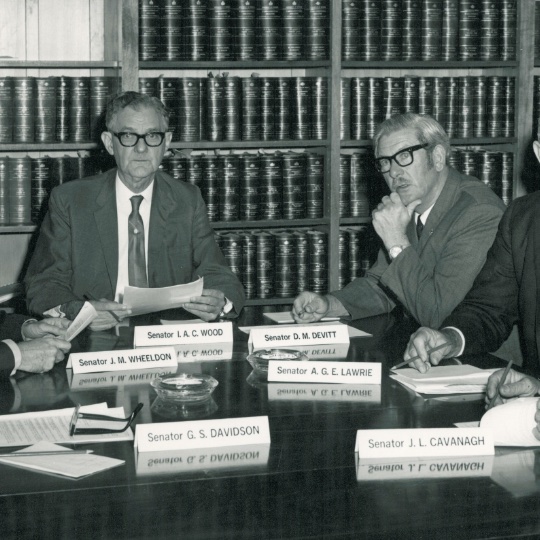First reference of a bill to a select committee
Clerk of the Senate JR Odgers studies the United States committee system
Described as ‘the watch-dog over untrammelled, executive regulation-making power’ and the ‘foundation stone’ of the Senate committee system, the Senate Regulations and Ordinances Committee enabled the Senate to monitor legislative instruments made by the executive government.
Many Acts of Parliament empower the government to make legislative instruments (such as regulations and rules), which provide much of the detail on the administration of Acts. While both houses of Parliament have the power to overrule most legislative instruments, in practice their overwhelming quantity and technical nature make it impossible for senators to examine them in detail.
A respected and bipartisan committee, the Regulations and Ordinances Committee checked all legislative instruments that came before Parliament to ensure that:
- individual rights and liberties were protected
- decisions made by government agencies could be independently reviewed and
- Parliament remained the pre-eminent maker of laws.
The findings of the committee were reported to the Senate which could decide to disallow (veto) the legislation. In 2019 the committee was renamed the Standing Committee for the Scrutiny of Delegated Legislation.
Members of the Regulations and Ordinances Committee in April 1971. From left, Senators Gordon Davidson, John Wheeldon, Ian Wood, Donald Devitt, Ellis Lawrie, Jim Cavanagh.
The Senate Regulations and Ordinances Committee has been emulated by many state parliaments and Commonwealth nations.

Portrait of Senator Ian Alexander Christie Wood, National Archives of Australia A1200, L96442
Ian Alexander Christie Wood
Senator Ian Wood, chair of the Regulations and Ordinances Committee (1953–73, 1976–78), recalled in 1984 how in disallowing regulations, ‘I was, most of the time, a member of the government that brought in those regulations and ordinances and as a consequence we always ran into trouble with our own government kicking up a row about knocking over their regulations’. According to Senator Wood, he convinced the Leader of the Government ‘that whatever the committee decides would be a decision of the Senate’.

Portrait of Senator Ian Alexander Christie Wood, National Archives of Australia A1200, L96442
Find Out More
|
Standing Committee on Regulations and Ordinances, Fourth Report, 23 June 1938
General review of Committee’s work since 1932 |
|
|
|
|
|
Ian Wood, Chair of the Regulations and Ordinances Committee (1953–73 and 1976–78), Interview with Ron Hurst on government recognition of committee decisions, 1984
National Library of Australia, ORAL TRC 4900/84, session 3, 25:19–26:26. |
|
|
Ian Wood, Chair of the Regulations and Ordinances Committee (1953–73 and 1976–78), Interview with Ron Hurst on international recognition of the committee, 1984
National Library of Australia, TRC 4900/84, session 3, 28:52–32:31. |
